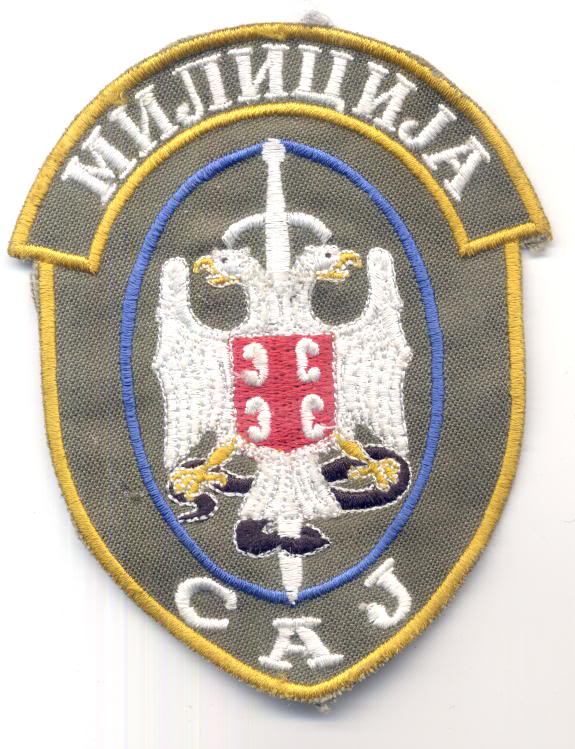History
In the former SFR Yugoslavia security services decided to establish a special team, which would be able to respond to the increasing phenomenon of terrorism in Europe. The need to establish such unit in a time when in Europe occurred various terrorist groups such as IRA, ETA, the German Baader-Meinhof, the Italian Red Brigade and others. The first is founded on the federal level, 13th May 1978[1] the detachment for special effects in the Federal Secretariat of Internal Affairs - SSUP, and was appointed the first commander Franz Kos. After seven months since the founding of the federal unit for special effects, a decision was taken to establish on republic and provincial levels a unit with the same purpose.
The Unit for Anti-terrorist effects (Jedinica za antiteroristička dejstva - JATD)[2] in the Republic Secretariat of Internal Affairs - RSUP of SR Serbia was established at Novi Beograd Milicija station on December 18, 1978. The first commander of unit was Miloš Bujenović. Main tasks of new formed unit were classical fight against terrorists, to prevent aircraft hijacking, release of hostages, the fight against organized crime and similar action of the high-risk in urban areas. In 1983 units base was relocated to the Belgrade airport and renamed in to Units for special effects (Jedinica za specijalan dejstva RSUP). In 1991 unit was again renamed in to Special units (Specijalne jedinice), and it's new commander was Radovan Stojičić. On June 1, 1992, Command of Special Anti-terrorist units (Komanda SAJ) was established, with Živko Trajković as commander. It consisted from Belgrade SAJ, under command of Zoran Simović Novi Sad SAJ, under command of Branko Ćuričić, and Units for special effects from Priština, which was under command of Nuredin Ibishi, until he has defect from police to so-called Kosovo Liberation Army in 1999. He was replaced with Radoslav Stalević.
Headquarters and Belgrade uint were relocated to Batajnica while maintaining other training centers at Paklenik, complete with a model town to practice Close Quarters Battle (CQB) and urban combat. On December 31, 1999, Belgrade, Novi Sad and Priština units were merged in to single unit under command of Živko Trajković The average SAJ member is between 20 and 35 years in age. Must be athletic and proficient in martial arts. Recruiting is conducted on May 13 every year.
Structure
Special Anti-terrorist Unit has two assault teams, A and B,logistics team C (snipers,K-9,EOD) and D team for security and support.Medical group,Group for construction and searching weapons and ammunition,Logistic group. SAJ duties include combating terrorism, insurgency, organized crime, hostage situations and high risk warrant executions as well as VIP protection.
Equipment
Like most counter-terrorist units around the world, the SAJ have standard SWAT equipment[3] with a substantial arsenal of weapons and vehicles at its disposal. Among some standard weapons used are Heckler & Koch MP5, Zastava M70, M4 carbine, SIG SG 552, H&K G3, SSG sniper rifles, CZ 99 pistol, riot control agents, stun grenades, and various other weapons. Sophisticated communications are standard issued along with other specialized equipment including heavy body armor, entry tools and night vision optics.
Of course a unit is only as good as its ability to get where it has to be. For aerial insertion the main mode of transport are Jet Ranger and Bell 212 twin helicopters from Serbian Police helicopter unit. In operations that require traversing in difficult and off road terrain, the most popular and abundant means are Pinzgauer's, Land Rover Defender's, BOV (APC) and also one BVP M-80 ICV/IFV. In urban operations the SAJ use Audi's and BMW's for collection purposes with specialized support vehicles at their side. The SAJ employs several different BDU's for use in various environments. These being Urban, Temperate, and Arid environments as well as night time operations.
Publicly known missions
- Action in 1989 at the miner's strikes in the Serbian province of Kosovo. It was here that they crushed the demonstrations, and became well-known.
- 1997 action against hijacker in Smederevo.
- 1998 crackdown on Kosovo Liberation Army (KLA). One such operation was destroying the KLA concentration in Donji Prekaz.
- 1999 Račak Operation.[4]
- Arresting the Zemun gang in "Operation Sword" 2003.
- Arresting the mass murder in July 2007 Jabukovac killings.





 Shopping Cart
Shopping Cart